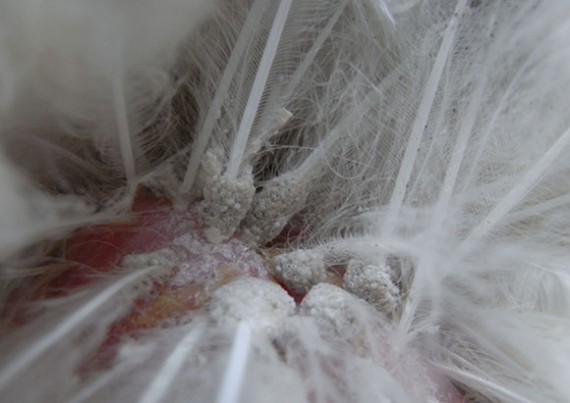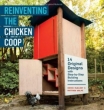Lice
Lice are flat, straw-yellow coloured external parasites that feed from skin and feather debris. They irritate your chickens and heavily infested birds will pull their feathers out or break feathers, trying to stop the irritation. Lice live on the bird, unlike red mite that live in the cracks of the chicken house, coming out to feed on chickens at night.
Chickens will minimise the number of lice they are carrying with dust baths and preening, but ex-battery hens that have been ‘de-beaked’ (the end of the beak trimmed) are more likely to become infested, as they cannot preen properly.
Lice spread by contact with other infected birds or their discarded feathers, so if one chicken in the flock is carrying lice then it is likely they all have them.
The Signs of Lice
Lice are normally 2 to 3mm long and can be found scurrying on the skin in warm places such as under wings or near the vent. They move quickly out of sight when the feathers are parted. When a chicken is carrying a lot of lice, eggs (called nits) will be found in clumps around the base of feather shafts near the vent. These are very hard to remove by hand without removing the feather.
 Nits clumped at the base of feather shafts below the vent.
Nits clumped at the base of feather shafts below the vent.
Treatment
Treating chickens for lice is straightforward enough using a delousing product that is approved for use on chickens. These products do not normally kill nits so you need to repeat the treatment again at weekly intervals for a few weeks.
Dust baths are a natural way for chickens to rid themselves of lice. Adding a powder to their dust bath (my favourite is diatomaceous earth) can be beneficial in controlling lice but be careful not to make dust baths too dusty as chickens are prone to respiratory problems.
Discarded feathers in the house and run can carry nits that re-infect the flock once they hatch so ensure you clean the coop out and rake up feathers from the run.
Many poultry keepers (especially those with large flocks) use an avermectin-based product such as Ivermectin, dropped onto the back of the neck in a similar way to ‘spot on’ products used for cat or dog flea treatment. Ivermectin has a residual effect and an extra benefit of killing most internal parasites (worms) as well.
Ivermectin isn’t licensed for use on poultry, which means you should only use it under the guidance of your vet. Avermectins are also more toxic to waterfowl than poultry so extra care needs to be taken if you are treating them.
- Previous « Red Mite
- Next Scaly Leg Mites »

About Tim Daniels
Tim is a poultry enthusiast and keeps chickens, ducks, and geese at his home in Bedfordshire. He runs the hobby website poultrykeeper.com in his spare time.
Further Reading
 Chicken & Eggs: River Cottage Handbook No.11 Mark Diacono |  Storey's Guide to Raising Chickens Gail Damerow |  A Beginners Guide to Caring for Ex-Batts Jo Barlow |  Reinventing the Chicken Coop Matthew Wolpe |  Chickens: The Essential Guide to Choosing and Keeping Happy, Healthy Hens Suzie Baldwin |
Smallholding shop
When you click links below and make a purchase, this may result in this site earning a commission from eBay.

Liquid Life Guard 250ml
100% Natural Plant Based… from £12.88 + p&p

Brinsea Mini Advance Incubator
Brinsea's Mini… from £127.95 + p&p

Mushroom Poultry Drinker 1.3li
Mushroom Poultry Drinker.… from £3.02 + p&p

Emporor Pheasant Feeder
Made form durable UV… from £72.69 + p&p
















